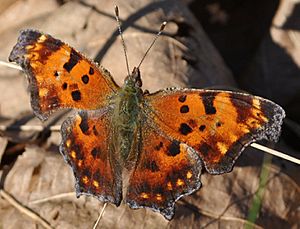Eastern comma facts for kids
Quick facts for kids Eastern comma |
|
|---|---|
 |
|
| Conservation status | |
| Scientific classification | |
 |
|
| Range map showing distribution of the eastern comma | |
| Synonyms | |
|
The eastern comma (scientific name: Polygonia comma) is a beautiful butterfly found in North America. It belongs to a large family of butterflies called Nymphalidae. This butterfly gets its name from a special mark on its wings.
Contents
What Does the Eastern Comma Look Like?
The eastern comma butterfly can look different depending on the season. In summer, the top of its back wings are mostly black. But in winter, these same wings are a reddish-orange color. Both summer and winter forms have stripes of dark and light brown on the underside of their wings.
A cool feature is a shiny, silver comma-shaped mark on the middle of its back wing. This mark is how the butterfly got its name! This butterfly's wings can spread about 4.5 to 6.4 centimeters wide.
Where Does the Eastern Comma Live?
You can often find eastern comma butterflies in wooded areas. They especially like places near water. Look for them near rivers, ponds, marshes, and swamps.
What Do Eastern Commas Eat?
Unlike many butterflies, eastern commas do not often visit flowers for nectar. Instead, they prefer other types of food. They like to feed on tree sap and rotting fruit. They also get important salts and minerals from wet mud, a behavior called "puddling." Sometimes, they even feed on animal dung.
What Plants Do Eastern Commas Need?
Female eastern comma butterflies lay their eggs on specific plants. These plants are called "host plants." The caterpillars then hatch and eat the leaves of these plants.
Some of their favorite host plants include:
- False nettle (Boehmeria cylindrica)
- Hops (Humulus)
- Wood nettle (Laportea canadensis)
- American elm (Ulmus americana)
- Nettle (Urtica)
The Eastern Comma Life Cycle
The life of an eastern comma butterfly starts as a tiny egg.
- Eggs: The green eggs are laid one by one, or sometimes in small stacks. They are usually placed on the underside of host plant leaves or stems.
- Larva (Caterpillar): Once hatched, the larva is a spiny caterpillar. Its color can vary a lot, from pale green to yellow, white, or even black. These caterpillars usually eat leaves at night. During the day, older caterpillars build shelters. They pull a single leaf together with silk to hide inside.
- Chrysalis: After growing, the caterpillar changes into a chrysalis. This is a brown casing covered with spines. Inside, the caterpillar transforms into a butterfly.
- Adult: Adult butterflies that emerge in the winter stay alive through the cold months. Some of them might even fly south to warmer places for the winter.
Similar Butterflies
Sometimes, the eastern comma can be mistaken for other butterflies. For example, the dark form of the eastern comma looks a bit like the question mark butterfly. However, you can tell them apart by looking at the comma mark on the underside of their wings. The shape of this mark is different.
Another similar butterfly is the satyr comma. This butterfly usually lives further north and west than the eastern comma. You can tell them apart by the color on the top of their wings. The eastern comma is orange-brown, while the satyr comma is more yellowish-brown. Also, the patterns on the underside of their wings look different.



